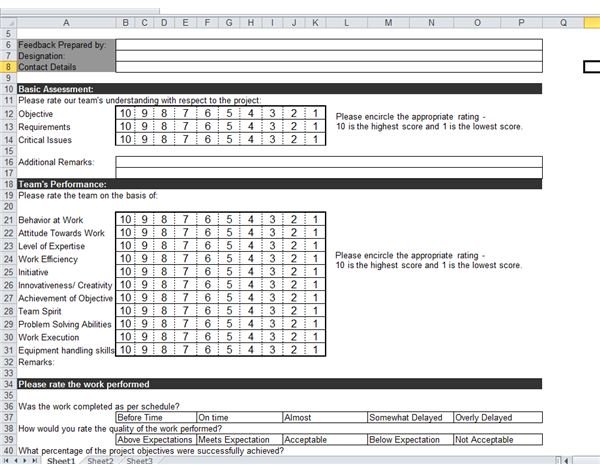Helpful Templates and Forms for Collaborative Teams
When collaborating on a project oftentimes the best way to kick things off is to have all collaborators meet and share their ideas over a brainstorming session. Brainstorming is critical to the collaboration process as it allows people the chance to share their voice on how the project should proceed from the very beginning. It also creates a more relaxed atmosphere as ideas continue to be generated throughout the collaboration process.
Additionally, it’s generally a good idea to have the infrastructure in place to recognize and deal with problems as they happen. Feedback and issue reporting is critical in a collaborative effort, and having templates for these things at the ready will greatly improve communication throughout the project.
Cutting the amount of time it takes to collaborate effectively is difficult but not impossible. Having forms and templates ready is a great way to save on precious time and resources, so select one of the following templates below and get your collaborative effort off to a strong start:
Helpful Templates for Brainstorming
Brainstorming in collaboration is essential for generating and expanding on new ideas to get your project where it needs to go. Having helpful templates gets brainstorming rolling and sustains a meaningful dialogue. These templates also provide the important function of cataloging the data collected from your brainstorming sessions–which is also important.
Brainstorm diagrams are great for a collaboration that has a lot of steps that need to be taken into account. They allow teams the

ability to visualize how their plans for the collaboration will fall in a rough time line of events. The process also helps to plot a clear path to get from the start of a project to the end goal of a project.
<strong>Listing Brainstorming Template</strong>
Listing is a method of brainstorming where you list your topic multiple times and then build off any ideas that spring up. This method is similiar to the diagram method but allows you and your collaborators to come up with different perspectives on the same problem. Seeing the project from different angles will allow you and your team to combine the best possible ideas from all areas and create a solid plan for collaboration.
Six Sides Brainstorming Template
Six-sided brainstorming takes the approach that each member of the team is given the topic, and each have to apply six methods to this topic. Each member will have to describe, analyze, compare, associate the topic with other things, apply the topic practically, and either argue for or against the topic. This gives everyone brainstorming on the collaboration the chance to apply their own thoughts and opinions to the topic at hand.
Classic Bubble Brainstorming Template
The classic bubble method of brainstorming is something taught very early on in education. It’s a method by which you surround the

topic with connecting ideas that are all related to the main topic or to each other in one way. It’s a simple strategy, but what it allows you and your team to do is throw everything you have at the wall and see what sticks.
Breakdown Brainstorming Template
Breakdowns are helpful when the topic is too big to grasp on its own. It forces the collaboration team members to separate the topic and then apply more effective brainstorming techniques to each of its parts. When ideas are combined at the end of the brainstorming session, the entire topic will be thoroughly discussed.
Free-writing is a more abstract technique, similar to the Bubble Method. Free-writing is when you take a pen to paper and just write out your thoughts for 15 to 20 minutes. Afterward, the thoughts are carefully analyzed and the best and most practical ideas are applied to a brainstorming session. Having multiple people brainstorm this way will give an interesting and uncut brainstorming session.
The weekly review is important for managing a collaborative project because it keeps you and your team updated on what’s going on in the project. Not only does it help manage time but it also helps to manage change as it arises. Any sort of change has the potential

to affect the collaboration dramatically to adapt to, so it’s important to catch it and deal with it as early and often as possible.
Monthly Team Status Report Template
If a weekly review is too taxing or ineffective because there is never or rarely an observable change, it might be better to switch to a monthly routine. You will still receive the same benefits yielded by a weekly review, but the process is now consolidated into a month-to-month view. This is great for observing substantial changes as they happen and will allow for larger but more effective collaboration sessions to occur.
Communication plans are critical when working on a collaborative effort. Without the proper infrastructure for communication there really won’t be much collaboration or brainstorming to speak of. Defining the parameters for communication will help your team better understand when it’s best to share their idea. This also creates the infrastructure to report changes, problems, or other ideas relating to the effort.
<strong>Project Issue Template</strong>
The Project Issue Template helps those who have recognized a problem with the collaboration project report the issue. Reporting

issues will create the need for brainstorming ways to adapt the project to the problem and work from there. Having a clear way to report issues will cut down on lost time and resources as well, and this template works that problem very well.
After an issue has been reported and the appropriate steps have been taken to correct the problem, it’s important to track its progress. Having a regular status report on the problem will keep you and your team up to date as the problem unfolds and is solved. This type of reporting will allow you and your collaboration team to focus efforts on that particular problem until it is completely solved.
Project Feedback Forms & Templates
In a similar vein, feedback forms allow collaborators to continue to express their thoughts and opinions on the collaboration outside of dedicated collaboration meetings. This opens up a constant stream of ideas and opinions flowing in toward building the project to be

the best. Continuing the flow of ideas allows for a constant look at different perspectives, which greatly improves the end result of a collaborative effort.
Excel Project Feedback Forms & Templates
Getting feedback from employees and collaborators is a great way of problem-solving issues during a collaborative effort. These forms provide the necessary documentation for collaborators to submit their thoughts on the work. Ultimately, the team will save a lot of time on the collaboration.

References
-
Images used from Flickr with Creative Commons Attribution-ShareAlike 2.0 Generic (CC BY-SA 2.0) License
-
Templates as depicted were created for Bright Hub by Ronda Roberts, Lin Parker and Sidharth Thakur
